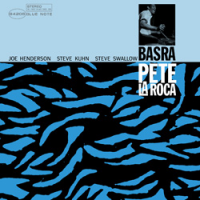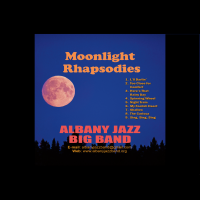Home » Jazz Articles » Big Band Report » Dave Brubeck: Small Groups, Large Stature
Dave Brubeck: Small Groups, Large Stature
Why Jazz Happened
I recently received in the mail a copy of Marc Myers' new book, Why Jazz Happened, which was obviously sent by someone who wasn't aware that I neither read nor review books. I do, however, read blogs including Myers' popular "Jazz Wax," and can say without pause that he is an excellent writer who is extremely knowledgeable about jazz of all stripes and eras. The book, which covers the years between World War II and Watergate, is described in a press release as "the first comprehensive social history of jazz." In other words, it places the music in context, outlining and analyzing the cultural forces that helped shape the music and gave rise to various post-war styles. It is written from the "inside out," encompassing numerous interviews and comments by musicians, producers, promoters and others who were on the scene and knew in detail what was happening. Publishers Weekly sums it up nicely: "In this energetic and captivating tale, Wall Street Journal music critic [Marc] Myers enthusiastically chronicles the many social, political, legal and monetary forces outside of music that shaped the evolution of jazz. With impeccable timing, Myers provides a steady backbeat of stories [about] the development of music from bebop, jazz-classical and West Coast jazz to spiritual jazz, jazz-pop and jazz-rock fusion . . . Like a great jazz recording, Myers's first-rate social history pulls us into its complex rhythms and harmonies, casting its mesmerizing spell." And that's as close as I'll come to reviewing a book, except to say, Marc, I hope it sells at least a million copies.
Closer to Home . . .
On December 7, Betty and I returned to Albuquerque's Manzano High School for a concert featuring the school's two jazz ensembles and the Albuquerque Jazz Orchestra with guest artist Mike Williams, the lead trumpeter with the Count Basie Orchestra. Williams also performed with the high school bands, which played well for director Brad Dubbs, soloing on Doug Beach's "Plunger Power," the Louis Armstrong staple "What a Wonderful World," and the Maynard Ferguson favorite, "Gonna Fly Now" (a.k.a. the theme from Rocky).
That set the tone for the evening as Williams, more lead player than jazz soloist, served primarily as high-note specialist with the AJO on "Begin the Beguine," "Over the Rainbow" (a trumpet duet with Dubbs), "Things Ain't What They Used to Be" (another with trumpeter Kent Erickson), "Maria" and "MacArthur Park." Williams sat out on the more jazz-oriented themes, Matt Catingub's "Thad-ish" and John Clayton's "Nice to Meet You." Dubbs (muted) and trombonist Christian Pincock were the soloists on "Thad-ish," Pincock, Erickson, pianist Jim Ahrend and tenor Lee Taylor on "Nice to Meet You." Taylor and AJO director / lead alto Glenn Kostur also soloed on "MacArthur Park," tenor Aaron Lovato on "Begin the Beguine." an enjoyable concert, tempered only by the fact that Williams, for all his talent, is best suited for section work than improvisation.
On the Horizon
The Monterey Jazz Festival's 55th Anniversary Celebration kicks off January 10 in Santa Cruz, CA, and continues through April 28, covering forty cities in twenty-three states. The all-star Monterey Festival Band features vocalist Dee Dee Bridgewater, bassist Christian McBride, drummer Lewis Nash, saxophonist Chris Potter, pianist Benny Green and trumpeter Ambrose Akinmusire. Highlights of the nine-week tour include a six-night run at the Blue Note in New York City and appearances at the Kennedy Center in Washington, DC; the Epcot Center in Calgary, Alberta, Canada; the Chicago Symphony Center, and Benaroya Hall in Seattle, WA. Information about the tour dates and times are available at www.montereyjazzfestival.com
Recent Releases
 Keith Karns Big Band
Keith Karns Big BandThought and Memory
Keith Karns Music
2013
For his inaugural recording as a big-band leader, trumpeter Keith T Karns, a native of Alaska who now teaches at the University of North Texas in Denton, has written and arranged a quartet of extended contemporary works to complement two by the legendary bassist Charles Mingus, "Gunslinging Bird" and "Better Get Hit in Your Soul." The longer pieces are separated at times by brief "Interludes" for solo instruments: the first for bassist Ken Ge (not to be confused with Kenny G), the second for pianist Steve Hobert, the third for Karns himself. Each of them segues seamlessly into the ensuing number.
Perhaps taking his cue from Mingus and others, Karns writes with one ear attuned to jazz tradition, the other centered on tomorrow and the path that big bands may choose to traverse as time-honored guidelines are cast aside to make way for new patterns. While melody has its place in this brave new world, it is less decisive than before, yielding some of its priority to the over-all form and substance of a particular composition. That's not to imply that melody is absent; far from it. On the other hand, when the song is ended the melody seldom lingers on (Mingus' "Soul," with its gospel-inflected strains, marks an exception to the rule).
Karns raises the curtain with "Wednesday Came to a Crossroads," which opens auspiciously after an intro by bassist Ge and pianist Hobert, moving pleasantly forward in 7/4 time before crisp solos by Karns, tenor Aaron Hedenstrom and drummer Brian Claxton lead to the "Crossroads," whose clamorous sonority calls to mind Times Square on New Year's eve. Hedenstrom solos again, with trombonist Nick Syman, on "Some Characters and Incidents Are Fictitious," on which Claxton's drums again play an essential role. After the first interlude, Karns' funky "Salt Water Rocket" takes flight, powered again by Claxton's emphatic drum work and earnest solos by Karns and tenor Brian Handelan}. "Thought and Memory," the last of Karns' compositions, is an opulent ballad on which Hedenstrom's expressive tenor is preceded by Hobert's eloquent commentary. Syman, Claxton and baritone Jon Vallejo are front and center on the bluesy "Gunslinging Bird," Hobert, Syman, Hedenstrom, Claxton, alto Jim Geddes and trumpeter Jeff Walk on "Better Get Hit in Your Soul."
Karns writes and arranges quite well in a contemporary vein, while the band is invariably poised and alert. As to whether the outcome is agreeable, that is a matter of taste. Karns' themes are unequivocally progressive, albeit in no way uncoupled from their more customary heritage. Those who are familiar with Mingus and his music may deduce for themselves the avenue that Karns aspires to traverse. Thought and Memory is a persuasive first step along that roadway.
 Norman David and the Eleventet
Norman David and the EleventetAt This Time
CoolCraft
2013
Norman David has done some moving around in his more than three decades as a respected working musician, and wherever he has gone, the Eleventet—his "passion for many years"—has come along for the ride: in Boston, Maine, New York City and, most recently, Philadelphia, from whence the group's latest incarnation has recorded the appropriately named At This Time. (As who knows where the Eleventet may be at this time a year from now, or a decade?) The title also denotes where David stands "at this time" in terms of composing and arranging; he wrote every number save the Academy Award-winning standard, "Secret Love," and arranged them all, as well as playing soprano saxophone in the ensemble's four-man reed section, which includes alto Dick Oatts, tenor George Garzone and baritone Mark Allen.
David's compositions are contemporary in the best sense of the word; there are, however, no tunes that linger long in the memory bank or lend themselves to whistling or humming. A few more standards would not have been amiss; "Secret Love" (given a minor-key make-over) is in fact a highlight, as well as a song that has stood the test of time and quickens the mind long after the recording has ended. That is not to say that David's compositions are less than agreeable, simply that they lack the allure or staying power of a "Secret Love." There's certainly no shame in that, as few songs do, especially those written to serve as jazz themes, not for mass consumption.
One advantage of an Eleventet (four saxophones, two trumpets, two trombones and rhythm) is that it can sound like a big band or small group, depending on the particular arrangement, and David writes with that in mind, blending bold ensemble passages with others that convey a small-group dynamic while setting aside ample space for improvisation. Oatts, Garzone and trumpeter Tim Hagans are widely known as resourceful soloists, and the others aren't far behind, especially Allen, pianist Tom Lawton and trombonist Randy Kapralick. Lawton is one-third of an unsung rhythm section (the others are bassist John Hebert and drummer Dan Monaghan) that performs admirably throughout. As for David, he is out front on three numbers, and his are the only solos that failed to produce an auspicious impression on these ears—a purely subjective appraisal, one with which other listeners may disagree.
When all is said, done and written, David and the Eleventet have recorded an album that is in its way as smart and stylish as any other, at least At This Time.
 Fred Hess Big Band
Fred Hess Big BandSpeak
Alison
2013
There was a time when most big bands based their persona on a handful of proven and predictable ingredients: tempestuous rhythms, formidable ensemble passages, screaming shout choruses. You could always be sure that Count Basie, Woody Herman, Stan Kenton or Buddy Rich would find more than one way to shake you out of your cozy seat and set your toes to tapping. That was then; this is now, when most bands are built along the lines of saxophonist Fred Hess's well-bred Colorado-based ensemble: able to swing hard when necessary but as a rule more closely attuned to the nature and subtleties of contemporary themes than their swaggering predecessors.
For Speak, his third big-band recording and sixteenth over-all, Hess has written and arranged five engaging tunes to accompany guitarist Tommy Walker's eloquent "Speak to Me" (which Hess also arranged), and has buttressed the ensemble by enlisting the sizable talents of trombonist John Fedchock who once wrote for and played in one of Woody Herman's celebrated Herds. Back for a third go-round is the versatile drummer Matt Wilson who keeps the rhythm section on its toes from beginning to end. Brass and reeds are earnest and attentive, working together like a well-oiled machine.
Fedchock solos nimbly on the genial opener, "Blues for Bonnie Belle" (named for Hess's pet dog), again (with trumpeter Alan Hood and alto John Gunther) on "Finding the Evidence" (inspired by a well-known piece by Thelonious Monk) and on the rapid-fire "Psalm to Hymn." Although Hess doesn't say so in the liner notes, the tenor solos on "Bonnie Belle," "Speak to Me" and "Psalm to Hymn" are presumably his, as no one else is mentioned. Tenor Peter Sommer steps front and center with trumpeter Ron Miles for persuasive solos on "Chutes and Ladders." "Psalm," the album's most expansive essay at 16:36, is a tribute to John Coltrane's "modal period," which to many is synonymous with his "discordant period." While Hess nods briefly to that (immediately following Fedchock's virile solo), the "Psalm" is for the most part decidedly straight-ahead and swinging, embodying assertive statements by Hess, Wilson, Gunther and pianist Marc Sabatella. Wilson, trombonist Nelson Hinds and alto Wil Swindler solo strongly on the kaleidoscopic "How 'Bout Now."
Of his three big-band recordings, Hess says Speak is "the best yet." No one here intends to argue the point, which is clearly a matter of opinion, albeit from someone whose viewpoint should be respected. What can be said is that the album stands securely on its own and is a worthy successor to the first two, Hold On and Into the Open. For those who are conversant with Hess's music, no more need be said; for those who aren't, check it out.
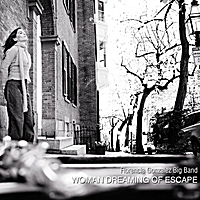 Florencia Gonzalez Big Band
Florencia Gonzalez Big BandWoman Dreaming of Escape
Self Published
2013
Woman Dreaming of Escape is a splendid debut recording by Uruguayan-born saxophonist Florencia Gonzalez' New York-based big band, replete with engaging melodies and authentic rhythms, from South America and elsewhere. Gonzalez formed the band in Boston in 2007 and moved it to New York City four years later, after it was named one of the five best bands in the Boston area. While the membership has, presumably, undergone some changes, those who perform on Woman Dreaming prove quite capable of assimilating Gonzalez' elaborate and forward-leaning charts, among the more raveled of which is "Miniatura Cromatica," a bow to the music of Bela Bartok and Gustav Mahler that, in Gonzalez' words, "visits the 12 tones, making them one by one the centers of small universes"—meanwhile giving the listener a lot of sustenance to chew on.
Gonzalez' other compositions are far more accessible (and melodic), starting with the lyrical curtain-raiser, "Hurry," and including "Woman Dreaming of Escape" (an "abstract tango" inspired by Stravinsky, Osaldo Puliese and Joan Miro), "Chacarera for Greg," "Candombe Estirado" and last but not least, "DEFG Blues," variations on a theme written by Bob Brookmeyer for the Thad Jones—Mel Lewis Orchestra in the '60s. The graceful "Chacarera," Gonzalez notes, "is deeply influenced by the music of two female composers: Paule Maurice and Maria Schneider," while "Candombe Estirado" (literally, Stretched Candombe), introduced by drummer Franco Pinna, "is a tribute to Duke Ellington," she writes, "his crazy harmonies, the darkness of his music and his Africanisms, and to the Africanisms of [her] own country." The Brookmeyer-influenced "Blues" is a chromatic theme in which Gonzalez took a tone row and built the entire piece "based on this row, from the bass line to the harmony, voicings, etc."
Ample room in each of her compositions is reserved for improvisation, primarily for woodwinds (Gonzalez herself is a saxophonist, although she doesn't play on the album). Another Gonzalez, Sofia, is one of three flute soloists on "Chacarera" (the others are Susanna Quilter and Art Felluca). Felluca, on clarinet, is the featured soloist on "Miniatura Cromatica." Guitarist Diego Porchile shares solo space with tenor saxophonist Andrew Halchak on "Hurry," with pianist Andrew Washburn and alto Nick Brust on "Woman Dreaming." Others who take their turn in the spotlight are trumpeters Chris Kottke and Greg Marchand, tenor Andy Voelker, trombonist Tim Schneier and drummer Pinna, each of whom is proficient and technically sound.
Even so, Woman Dreaming is in most respects a showcase for Gonzalez' ultra-modern compositions and arrangements, and she doesn't disappoint. As another flag-bearer in the ranks of such avant-garde writers as Schneider, Carla Bley, Hazel Leach, Christina Fuchs and others, Gonzalez has made the sort of remarkable beginning that presages a bright and productive future.
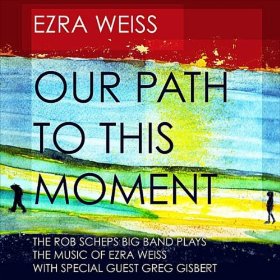 Ezra Weiss / Rob Scheps Big Band
Ezra Weiss / Rob Scheps Big BandOur Path to This Moment
Roark Records
2013
On his first recording as leader of a big band, Oregon-based composer / arranger Ezra Weiss epitomizes "contemporary" in the best sense of the word. It helps, of course, to have an ensemble as proficient as that supervised by saxophonist Rob Scheps and a guest artist of the caliber of trumpeter Greg Gisbert to interpret and enhance Weiss's elaborate charts. Weiss wrote five of the seven numbers to complement the standard "It's You or No One" and the well-traveled spiritual "Wayfaring Stranger," on which Gisbert frames an engaging solo (as he does on "Our Path to This Moment" and "Rise and Fall").
Besides composing and arranging, Weiss plays sparkling piano on "It's You," the melodically lustrous "Kunlangeta" and graceful "Jessie's Song," written for his wife. Scheps solos as well, and robustly, on soprano ("Our Path") and tenor sax ("It's You," "Wayfaring Stranger"). Trombonist Craig Hilton and Tomas Phillips is showcased on "Kunlangeta," while baritone saxophonist Robert Crowell spars with Gisbert on "Rise and Fall." Other soloists of note are trumpeter Paul Mazzio ("It's You"), alto David Valdez and pianist Ramsey Embric} ("The Promise"), tenor Scott Hall ("Jessie's Song"), drummer Ward Griffiths and conguero Chaz Mortimer ("Wayfaring Stranger").
Even so, it is Weiss's burnished arrangements that entice the ear, as he paints a series of entrancing sound-pictures that are progressive in nature while well-grounded in the musical essentials: melody, harmony and rhythm. Our Path to This Moment embodies one more forward step for contemporary big bands, one that is remarkably engaging by any measure.
Seasonal Sounds
 Octobop
OctobopWest Coast Christmas
Self Published
2013
What would the Christmas season be without music? Much less festive, that's for sure. And even without the snow and ice, that's as true on the West Coast as it is on the East. Out in sunny California, baritone saxophonist Geoff Roach's Octobop is spreading seasonal cheer with a new CD, West Coast Christmas, on which clever arrangements of holiday favorites help brighten the landscape. In keeping with its West Coast provenance, Roach's eight-member group has "borrowed" from such peerless role models as Gerry Mulligan ("Line for Santa," "Bernie's Bells") and Shorty Rogers ("Saturnian Sleigh Ride," based on the Leroy Anderson classic) to enhance the holiday mood.
Roach arranged those numbers to complement charts by guitarist Jack Conway (six), bassist Brian Brockhouse ("Angels We Have Heard on High") and trumpeter Randy Smith ("Carol of the Bells"). "Line for Santa" blends passages from Mulligan's "Line for Lyons" with "Santa Claus Is Coming to Town," while "Bernie's Bells" is an amalgam of "Bernie's Tune" and "Jingle Bells." There is at least one lesser-known tune, "Filho de Papai Noel," and at on the pre-release copy, "God Rest Ye Merry, Gentlemen" is listed as "Jerry Mendelbaum." Both were arranged by Conway, as were "Santa Baby," "Christmas Time Is Here," "It Came Upon a Midnight Clear" and "The Christmas Song."
This is the fifth album by Octobop, which is no doubt comfortable in a recording studio. The ensemble plays well together, and solos are by and large passable, even though it's clear there's no Mulligan or Rogers in the neighborhood. On the other hand, the playing time is less than thirty-eight minutes, rather unsuitable for a present-day compact disc, which prospective listeners should keep in mind. A smooth, easygoing session for those who are looking for some Christmas music that is slightly off the beaten path.
 Jasper Wood / David Riley
Jasper Wood / David RileyStradivarius Christmas
Max Frank Music
2013
For music that is even more out of the ordinary, there's Stradivarius Christmas, on which violinist Jasper Wood teams with pianist David Riley to offer elegant interpretations of seasonal staples with "musical settings" (arrangements?) by Terry Vosbein, who is well-known to followers of big-band jazz for a pair of impressive albums with the Knoxville Jazz Orchestra, Progressive Jazz 2009 and Fleet Street (songs from the Broadway musical Sweeney Todd.) Although no biographical information is given on the CD jacket (and there are no liner notes), Wood is from Canada, Riley (a professor at the University of Oregon) may also be Canadian by birth, and the duo has recorded at least one earlier album, Stravinsky: Works for Violin and Piano.
Wood may indeed be playing a Stradivarius, but it makes little difference. What matters is that he is a virtuoso on the instrument, as is pianist Riley, and that they play marvelously (and flawlessly) together. As for the program, it encompasses sixteen holiday evergreens from "O Tannenbaum" to "Auld Lang Syne" with stops in between for such well-known hymns as "We Three Kings," "Angels We Have Heard on High," "It Came Upon a Midnight Clear," "O Holy Night" and "God Rest Ye Merry, Gentlemen." Less often heard (but no less charming) are "I Wonder as I Wander," "Bring a Torch, Jeanette, Isabella," "Fum Fum Fum," "What Child Is This" and "O Come O Come, Emmanuel." On the "jazzier" side, Wood and Riley have some fun with Vosbein's light-hearted "Christmas Rag."
For holiday parties, this is familiar yet beguiling music fashioned to make everyone feel at home. Apart from that, it is superbly planned and performed, with crystal-clear sound adding to its allure. No jazz, simply beautiful music to enhance the Christmas season.
In Smaller Packages . . .
 Roberto Magris Space Trek
Roberto Magris Space TrekAliens in a Bebop Planet
Jmood Records
2013
Composer / pianist Roberto Magris roams far afield on this seductive two-disc set, leaving his native Italy to record in Kansas City, MO, and using as his premise the bewilderment of aliens who encounter bebop, apparently for the first time, after arriving on planet earth (or "planet jazz"). What the aliens chance upon, in fact, transcends bebop, as Magris makes them feel "at home" with a variety of exotic themes that range from swing to "free" jazz and whose moods and cadences hint from time to time at the possibility of some far distant origin. Always, however, there is an explicit bebop substructure, one on which even aliens can depend.
Magris' accomplices in this endeavor include tenor saxophonist Matt Otto, bassist Dominique Sanders and drummer Brian Steever, with percussionist Pablo Sanhueza added on ten tracks, vocalist Eddie Charles on "Aliens," "New Cos City" and "Nobody Knows." The leader's piano is heard alone on the opening "Blues Clues," and with Otto's tenor on "Cloud Nine." Otto, a new name here, is a laid-back bopper whose tone and temper are reminiscent of Brew Moore / Allen Eager / Warne Marsh with a touch of Stan Getz. Magris wrote thirteen tunes and most likely arranged everything. Rounding out the engaging program are Fats Navarro's "Nostalgia," Billy Reid's pop favorite from 1947, "The Gypsy," Kenny Clarke's "Nobody Knows," John Coltrane's "Giant Steps" and "Robbin's Space Bolero," easily noted as Sir Sir Charles Thompson's classic "Robbin's Nest." The last nineteen minutes on Disc 2 comprise an "audio notebook," akin to spoken liner notes, which summarize everything you need to know about the album after you've already listened.
What should be of paramount interest to anyone who has positioned the recording on his or her radar screen is the fact that Magris covers a variety of styles and plays well in all of them, as do Otto and the others. As for Chambers, he's a wordsmith in the mold of King Pleasure or Eddie Jefferson, to name a couple (he sings on two numbers and "talks" on "New Cos City"). Magris strings together a number of well-known bop phrases on "New Cos City," and swings as earnestly as any bopper on that number, as well as on "The Gypsy," "Cosmic Storyville," "Nostalgia" and the Latin-centered "Chachanada." The rhythm section, also faced with the task of mastering a number of blueprints, has no problem adapting its outlook to suit each revision.
A picturesque and perceptive voyage across the jazz landscape for aliens and earthlings alike.
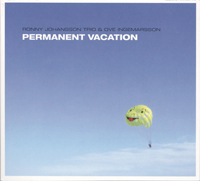 Ronny Johansson Trio
Ronny Johansson TrioNew Jubilee / Permanent Vacation
Mori Music
2013
Ronny Johansson, a world-class pianist from Sweden who plays with deceptively youthful enthusiasm and power, is no young lion; far from it, in fact, as he has played an important role in the music scene in his home country (and elsewhere) for more than half a century (with no perceptible sign of slowing down). Johansson is clearly at the top of his game on these CDs, which were recorded two years apart: New Jubilee in 2012, Permanent Vacation in 2010, both with his working trio, bassist Yasuhito Mori and drummer Raymond Karlsson. Tenor saxophonist Ove Ingemarsson adds his singular voice to five numbers on the earlier session.
All of the songs on both CDs were written and arranged by Johansson, whose bright and lyrical compositions mirror closely his approach to the keyboard. As a soloist / accompanist, he brings to mind another Swedish master, Jan Lundgren, and there aren't many compliments more lavish than that. It could be said without rebuttal that Lundgren has actually followed in Johansson's footsteps, as Ronny got there first. Whatever the case, there's no denying that Johansson and Lundgren are extraordinary pianists who excel at writing and whose import has been enormous. If you're a Lundgren fan, and there are many throughout the world, you'll certainly appreciate what Johansson brings to the table.
Johansson has two more things going for him, namely Mori and Karlsson, whose seamless back-up work anchors the trio securely and helps raise it to a consistently impressive level. Johansson most often writes with themes in mind, as the songs on both albums affirm. On New Jubilee, for example, "My Japanese Heart" extols the trio's tour of Japan in 2010, while "My French Heart" recalls an evening at the Blue Note in Paris where Johansson saw and heard Bud Powell and Victor Feldman perform. "Hope" was written in the wake of the tsunami that devastated parts of Japan, "Aries" for Johansson's wife, Ulla. "Piano Noir" is a play on words (pinot noir, anyone?), "See You" a brief essay for solo piano.
The same holds true on Permanent Vacation, wherein Johansson's graceful melodies are given added color by his longtime friend and colleague, Ingemarsson, with whom he has recorded before. "Thanks HSM and Goodbye" and "Permanent Vacation" apparently refer to Johansson's retirement after thirty-four years of teaching piano, most recently at the State College of Music in Goteborg. While "Raymond on the Bike" remains unknown, he seems to be having a marvelous ride, something that holds true for the listener throughout both these splendid albums by one of the most accomplished trios you've probably never heard.
Tracks and Personnel
Thought and Memory
Tracks: Wednesday Came to a Crossroads; Some Characters and Incidents are Fictitious; Interlude I; Salt Water Rocket; Interlude II; Thought and Memory; Gunslinging Bird; Interlude III; Better Get Hit in Your Soul.
Personnel: Keith Karns: composer, arranger, trumpet; Jeff Walk: trumpet; Paul Stodolka: trumpet; Elizabeth Tomlinson: trumpet; Josh Fuchs: trumpet; Jim Geddes, Justin Kevan, Aaron Hedenstrom, Brian Handeland, Jon Vallejo: saxophones; Joe Hartson: trombone; Nick Syman: trombone; Jason Marshall: trombone; Josh Becker: trombone; Steve Hobert: piano; Ken Ge: bass; Brian Claxton: drums; Courtney Karns: vocals.
At This Time
Tracks: Nor-Bop; Tuesday Overture; Line-Up; Vicinity; Random Orders; Quick, Change!; It's Complicated; At This Time; Secret Love; Going Way Up.
Personnel: Norman David: composer, arranger, soprano sax; Dennis Wasko: trumpet; Tim Hagans: trumpet; Dick Oatts: alto, soprano sax; George Garzone: tenor sax; Mark Allen: baritone, tenor sax; Randy Kapralick: trombone; Jarred Antonacci: trombone; Tom Lawton: piano; John Hebert: bass; Dan Monaghan: drums.
Speak
Tracks: Blues for Bonnie Belle; How 'Bout Now; Speak to Me; Chutes and Ladders; Finding the Evidence; Psalm to Hymn.
Personnel: Fred Hess: composer, arranger, tenor sax; Tyler Gilmore: conductor; Pete Olstad: trumpet; Dave Rajewski: trumpet; Al Hood: trumpet; Ron Miles: trumpet; John Gunther, Wil Swindler, Peter Sommer, Mark Harris: reeds; John Fedchock: trombone; Nelson Hinds: trombone; Hoyt Andres: trombone; Gary Mayne: trombone; Marc Sabatella: piano; Greg Garrison: bass; Matt Wilson: drums.
Woman Dreaming of Escape
Tracks: Hurry; Mujer Sonando con la Evasion; Chacarera para Greg; Candombe Estirado; Miniatura Cromatica; D E F G Blues.
Personnel: Florencia Gonzalez: composer, arranger, leader; Josh Mizruchi: trumpet, flugelhorn; Greg Marchand: trumpet, flugelhorn; Sam Dechenne: trumpet, flugelhorn; Chris Kottke: trumpet, flugelhorn; Art Felluca: alto sax, clarinet, flute; Nick Brust: alto sax, clarinet, flute; Andy Voelker: tenor, soprano sax; Andrew Halchak: tenor sax, clarinet, flute; Mike Jacobs: baritone sax, bass clarinet; Susanna Quilter: flute; Sofia Gonzalez: flute; Tim Schneier: trombone; Pete Fanelli: trombone; David Schwartz: bass trombone; Diego Porchile: guitar; Andrew Washburn: piano; Mariana Iranzi: bass; Franco Pinna: drums.
Our Path to This Moment
Tracks: Our Path to This Moment; Rise and Fall; It's You or No One; Kunlangeta; The Promise; Jessie's Song; Wayfaring Stranger.
Personnel: Ezra Weiss: composer, arranger, piano (3, 4, 6). Rob Scheps Big Band—Rob Scheps: leader, alto, soprano, tenor sax; Rich Cooper: trumpet; Paul Mazzio: trumpet; Greg Garrett: trumpet; Conte Bennett: trumpet; Gary Harris, David Valdez, Scott Hall, Robert Crowell: reeds; Stan Bock: trombone; Tom Hill: trombone; John Moak: trombone; Jattik Clark: tuba; Ramsey Embick: piano (1, 2, 5, 7); Tim Gilson: bass; Ward Griffiths: drums; Chaz Mortimer: percussion (3, 7). Special guest artist—Greg Gisbert: trumpet (1, 2, 7).
West Coast Christmas
Tracks: Line for Santa; Santa Baby; Christmas Time Is Here; Jerry Mandelbaum; Filho de Papai Noel J; Bernie's Bells; It Came Upon a Midnight Clear; The Christmas Song; Angels We Have Heard on High; Saturnian Sleigh Ride; Carol of the Bells.
Personnel: Geoff Roach: leader, baritone, tenor sax, flute; Randy Smith: trumpet, flugelhorn; Matt Kesner: tenor, alto, soprano sax; Jon Schermer: trombone; Jack Conway: guitar; Dave Casini: vibes (1, 3, 5-7, 9-11); Rick Gray: vibes (2, 4, 8); Brian Brockhouse: bass; Roddy Magallanes: drums.
Stradivarius Christmas
Tracks: O Tannenbaum; Away in a Manger; God Rest Ye Merry, Gentlemen; Jingle Bells; O Little Town of Bethlehem; I Wonder as I Wander; Bring a Torch Jeanette Isabella; We Three Kings; O Come O Come, Emmanuel; O Holy Night / Ave Maria; Fum Fum Fum; Whlat Child Is This; Angels We Have Heard on High; It Came Upon a Midnight Clear; A Christmas Rag; Auld Lang Syne.
Personnel: Jasper Wood: violin; David Riley: piano; Terry Vosbein: musical settings.
Aliens in a Bebop Planet
Tracks: CD1: Blues Clues on the Lunar Sand; Across the Borders / Beyond the Faith; A Night in Cydonia; Nostalgia; On Cloud Nine; Sat; Robbin's Space Bolero; Aliens in a Bebop Planet; Chachanada. CD2:New Cos City; Signals and Prayer; The Gypsy; Nobody Knows; Cosmic Storyville; Giant Steps; Rhythms from the Floating Space; On Cloud Nine (duet); Saturn Sun Ra; Audio Notebook.
Personnel: Roberto Magris: composer, arranger, piano; Matt Otto: tenor sax; Dominique Sanders: bass; Brian Steever: drums; Pablo Sanhueza: congas, percussion; Eddie Charles: vocals (8, 10, 13).
New Jubilee / Permanent Vacation
Tracks: New Jubilee: My Japanese Heart; My French Heart; Happy Birthday Blues; New Hymn; Intro; Hope; True Romance; Monte Misto; Piano Noir; Juan-les-Pins; Aries; See You. Permanent Vacation: Champagne, Please; Thanks HSM and Goodbye; Permanent Vacation; Japanese Blue; Flying High; Blue Waltz; Raymond on the Bike; A Song for U; More Champagne, Please.
Personnel: New Jubilee: Ronny Johansson: piano; Yasuhito Mori: bass; Raymond Karlsson: drums. Permanent Vacation: Same as New Jubilee but add Ove Ingemarsson: tenor sax (3, 5-8).
New and Noteworthy
1. R:3 Special Big Band, R3 (Summit Records)
2. Bob Mintzer Big Band, For the Moment (MCG Jazz)
3. Kris Berg / Metroplexity Big Band, This Time / Last Year (MAMA Records)
4. Albert-Hobbs Big Band, Love Remembered (Eidolon Productions)
5. Sandviken Big Band, In the Name of Freedom (Imogena)
6. Steve Taylor Big Band Explosion, Live in London (i2i Music)
7. Joe Chambers Moving Pictures Orchestra, Live at Dizzy's
8. Bob Wilber and the Tuxedo Jazz Orchestra, Rampage! (Arbors Jazz)
9. Howard University Jazz Ensemble, Ode to Life (HUJE Jazz)
10. DiMartino / Osland Jazz Orchestra, Quotient (Sea Breeze Jazz)
11. Washington State University, Zoot Suit (WSU Recordings)
12. Brussels Jazz Orchestra, A Different Porgy, Another Bess (Naïve)
13. Urban Renewal Project, Go Big or Go Home (URP Music)
14. Empire Jazz Orchestra, Accentuate the Positive (EJO)
15. Eastern Illinois University, Three O'Clock Downbeat (Self Published)
Tags
Big Band Report
Jack Bowers
United States
Dave Brubeck
Paul Desmond
Gerry Mulligan
Mike Williams
Count Basie
Louis Armstrong
Maynard Ferguson
Matt Catingub
John Clayton
Dee Dee Bridgewater
Christian McBride
Lewis Nash
Chris Potter
Benny Green
ambrose akinmusire
Keith Karns
Charles Mingus
Ken Ge
Aaron Hedenstrom
Jeff Walk
Norman David
Dick Oatts
George Garzone
Mark Allen
Tim Hagans
Tom Lawton
Randy Kapralick
John Hebert
Dan Monaghan
Woody Herman
Stan Kenton
Buddy Rich
Fred Hess
John Fedchock
Matt Wilson
Al Hood
John Gunther
Thelonious Monk
Peter Sommer
Ron Miles
John Coltrane
Marc Sabatella
Nelson Hinds
Wil Swindler
Florencia Gonzalez
Bob Brookmeyer
Thad Jones
Mel Lewis
Maria Schneider
Franco Pinna
duke ellington
Art Felluca
Andrew Halch
Chris Kottke
Andy Voelker
carla bley
Ezra Weiss
Rob Scheps
Greg Gisbert
Tom Hill
Robert Crowell
Paul Mazzio
David Valdez
Scott Hall
Geoff Roach
Shorty Rogers
Roberto Magris
Matt Otto
Dominique Sanders
Brian Steever
Brew Moore
Allen Eager
Warne Marsh
Stan Getz
Fats Navarro
Kenny Clarke
Charles Thompson
Ronny Johansson
Ove Ingemarsson
Jan Lundgren
Bud Powell
Victor Feldman
PREVIOUS / NEXT
Support All About Jazz
 All About Jazz has been a pillar of jazz since 1995, championing it as an art form and, more importantly, supporting the musicians who make it. Our enduring commitment has made "AAJ" one of the most culturally important websites of its kind, read by hundreds of thousands of fans, musicians and industry figures every month.
All About Jazz has been a pillar of jazz since 1995, championing it as an art form and, more importantly, supporting the musicians who make it. Our enduring commitment has made "AAJ" one of the most culturally important websites of its kind, read by hundreds of thousands of fans, musicians and industry figures every month.


